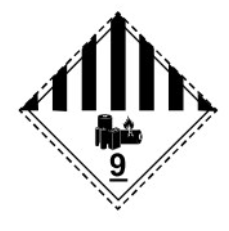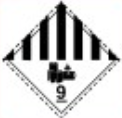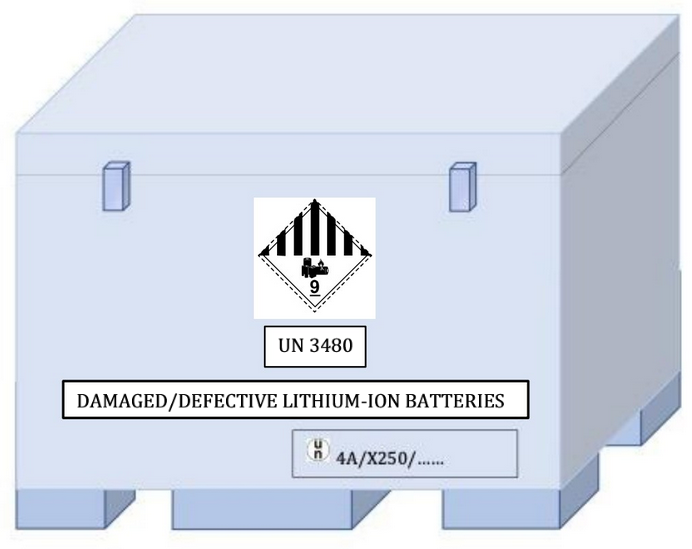Transport P911 LP906
CELLS AND BATTERIES DAMAGED & DEFECTIVE – Critical
Liable to dangerously react during transport
Applies to:
Lithium ion and lithium metal cells and batteries, damaged or defective, including those contained in equipment, liable to
dangerously react during transport
UN No., Proper
Shipping Name
UN 3090, LITHIUM METAL BATTERIES or UN 3091, LITHIUM METAL BATTERIES CONTAINED IN EQUIPMENT
UN 3480, LITHIUM ION BATTERIES or UN 3481, LITHIUM ION BATTERIES CONTAINED IN EQUIPMENT
Class
9
Hazard Label
• Labels must be in the form of a square set at an angle of 45° (diamond-shaped) with minimum dimensions of 100
mm by 100 mm; except for air transport mode, labels dimensions may be reduced in the case of packages of such
dimensions that they can only bear smaller labels.
• They must have a line 5 mm inside the edge and running parallel with it.

Prerequisite
• Cells and batteries liable to rapidly disassemble, dangerously react, produce a flame or a dangerous
evolution of heat or a dangerous emission of toxic, corrosive or flammable gases or vapours under normal
conditions of carriage, shall be carried according the following P911 and LP906 or under conditions
specified by the competent authority.
Transport mode
ADR
IMDG
IATA
Forbidden
376
376
Special
Provisions
Lithium ion cells or batteries and lithium metal cells or batteries identified as being damaged or defective such that they do not
conform to the type tested according to the applicable provisions of the Manual of Tests and Criteria shall comply with the
requirements of this special provision.
For the purposes of this special provision, these may include, but are not limited to:
– Cells or batteries identified as being defective for safety reasons;
– Cells or batteries that have leaked or vented;
– Cells or batteries that cannot be diagnosed prior to carriage; or
– Cells or batteries that have sustained physical or mechanical damage.
NOTE: In assessing a cell or battery as damaged or defective, an assessment or evaluation shall be performed based on safety criteria from
the cell, battery or product manufacturer or by a technical expert with knowledge of the cell’s or battery’s safety features. An assessment
or evaluation may include, but is not limited to, the following criteria:
(a) Acute hazard, such as gas, fire, or electrolyte leaking;
(b) The use or misuse of the cell or battery;
(c) Signs of physical damage, such as deformation to cell or battery casing, or colours on the casing;
(d) External and internal short circuit protection, such as voltage or isolation measures;
(e) The condition of the cell or battery safety features; or
(f) Damage to any internal safety components, such as the battery management system.”
Cells and batteries shall be packed in accordance with packing instructions P911 or LP906, as applicable
Packing
instructions
P911
P911
Use only approved packaging conforming to Packing Group I performance level:
• Drums (1A2, 1B2, 1N2, 1H2, 1D, 1G);
• Boxes (4A, 4B, 4N, 4C1, 4C2, 4D, 4F, 4G, 4H1, 4H2)
• Jerricans (3A2, 3B2, 3H2)
LP906
LP906
Large packagings are authorized for a single battery and for a single item of equipment containing batteries.
Use only approved rigid large packaging conforming to Packing Group I performance level, made of:
• steel (50A) • rigid plastics (50H)
• aluminium (50B) • plywood (50D)
• metal other than steel or aluminium (50N) • rigid fibreboard (50G)
Packing
additional
requirements
Packagings and large packaging shall be capable of meeting the following additional performance requirements in case of rapid
disassembly, dangerous reaction, production of a flame or a dangerous evolution of heat or a dangerous emission of toxic, corrosive
or flammable gases or vapours of the battery:
a. The outside surface temperature of the completed package shall not have a temperature of more than 100 °C. A momentary
spike in temperature up to 200 °C is acceptable;
b. No flame shall occur outside the package;
c. No projectiles shall exit the package;
d. The structural integrity of the package shall be maintained; and
e. Packagings and large packagings shall have a gas management system (e.g. filter system, air circulation, containment for gas,
gas tight packaging etc.), as appropriate.
The additional large packaging performance requirements shall be verified by a test as specified by the competent authority.
A verification report shall be available on request. As a minimum requirement, the battery name, the battery number, the mass, type,
energy content of the batteries, the large packaging identification and the test data according to the verification method as specified
by the competent authority shall be listed in the verification report.
Batteries shall be protected against short circuit.
Weight limit
No limit
No limit
Tunnel code
€
–
Transport cat.
0
–
Exemption
Marking and
Labelling of
Packages
UN 3090 or UN3091 or UN 3480 or UN3481
UN 3090, LITHIUM METAL BATTERIES or UN 3091, LITHIUM METAL BATTERIES CONTAINED IN EQUIPMENT or UN 3480, LITHIUM ION BATTERIES or UN 3481, LITHIUM ION BATTERIES CONTAINED IN EQUIPMENT


DAMAGED/DEFECTIVE LITHIUM-ION BATTERIES OR DAMAGED/DEFECTIVE LITHIUM METAL BATTERIES
DAMAGED/DEFECTIVE LITHIUM-ION BATTERIES
or DAMAGED/DEFECTIVE LITHIUM METAL BATTERIES
Overpack
OVERPACK + same labels as above
OVERPACK + same labels as above
Documents
Transport document
The transport document shall include the following
statement “Transport in accordance with special
provision 376”.
MDGF
The transport document shall include the following statement
“Transport in accordance with special
provision 376”.
Practical example of packaging, marking and labelling of packages containing cells and batteries Damaged or Defective Liable to
dangerously react during transport.

Special packaging with additional performance requirements that shall be
verified by a test as specified by the competent authority.
In case of rapid disassembly, dangerous reaction, production of a flame or a
dangerous evolution of heat or a dangerous emission of toxic, corrosive or
flammable gases or vapours of the battery
a. The outside surface temperature of the completed package shall not have
a temperature of more than 100 °C. A momentary spike in temperature
up to 200 °C is acceptable;
b. No flame shall occur outside the package;
c. No projectiles shall exit the package;
d. The structural integrity of the package shall be maintained; and
e. Packagings and large packagings shall have a gas management system
(e.g. filter system, air circulation, containment for gas, gas tight
packaging etc.), as appropriate.
| CELLS AND BATTERIES DAMAGED & DEFECTIVE – Critical Liable to dangerously react during transport |
||||||
|---|---|---|---|---|---|---|
| Applies to: | Lithium ion and lithium metal cells and batteries, damaged or defective, including those contained in equipment, liable to dangerously react during transport |
|||||
| UN No., Proper Shipping Name |
UN 3090, LITHIUM METAL BATTERIES or UN 3091, LITHIUM METAL BATTERIES CONTAINED IN EQUIPMENT UN 3480, LITHIUM ION BATTERIES or UN 3481, LITHIUM ION BATTERIES CONTAINED IN EQUIPMENT |
|||||
| Class | 9 | |||||
| Hazard Label | • Labels must be in the form of a square set at an angle of 45° (diamond-shaped) with minimum dimensions of 100 mm by 100 mm; except for air transport mode, labels dimensions may be reduced in the case of packages of such dimensions that they can only bear smaller labels. • They must have a line 5 mm inside the edge and running parallel with it. |
 |
||||
| Prerequisite | • Cells and batteries liable to rapidly disassemble, dangerously react, produce a flame or a dangerous evolution of heat or a dangerous emission of toxic, corrosive or flammable gases or vapours under normal conditions of carriage, shall be carried according the following P911 and LP906 or under conditions specified by the competent authority. |
|||||
| Transport mode | ADR | IMDG | IATA Forbidden |
|||
| 376 | 376 | |||||
| Special Provisions |
Lithium ion cells or batteries and lithium metal cells or batteries identified as being damaged or defective such that they do not conform to the type tested according to the applicable provisions of the Manual of Tests and Criteria shall comply with the requirements of this special provision. For the purposes of this special provision, these may include, but are not limited to: – Cells or batteries identified as being defective for safety reasons; – Cells or batteries that have leaked or vented; – Cells or batteries that cannot be diagnosed prior to carriage; or – Cells or batteries that have sustained physical or mechanical damage. NOTE: In assessing a cell or battery as damaged or defective, an assessment or evaluation shall be performed based on safety criteria from the cell, battery or product manufacturer or by a technical expert with knowledge of the cell’s or battery’s safety features. An assessment or evaluation may include, but is not limited to, the following criteria: (a) Acute hazard, such as gas, fire, or electrolyte leaking; (b) The use or misuse of the cell or battery; (c) Signs of physical damage, such as deformation to cell or battery casing, or colours on the casing; (d) External and internal short circuit protection, such as voltage or isolation measures; (e) The condition of the cell or battery safety features; or (f) Damage to any internal safety components, such as the battery management system.” |
|||||
| Cells and batteries shall be packed in accordance with packing instructions P911 or LP906, as applicable | ||||||
| Packing instructions |
P911 | P911 | ||||
| Use only approved packaging conforming to Packing Group I performance level: • Drums (1A2, 1B2, 1N2, 1H2, 1D, 1G); • Boxes (4A, 4B, 4N, 4C1, 4C2, 4D, 4F, 4G, 4H1, 4H2) • Jerricans (3A2, 3B2, 3H2) |
||||||
| LP906 | LP906 | |||||
| Large packagings are authorized for a single battery and for a single item of equipment containing batteries. Use only approved rigid large packaging conforming to Packing Group I performance level, made of: • steel (50A) • rigid plastics (50H) • aluminium (50B) • plywood (50D) • metal other than steel or aluminium (50N) • rigid fibreboard (50G) |
||||||
| Packing additional requirements |
Packagings and large packaging shall be capable of meeting the following additional performance requirements in case of rapid disassembly, dangerous reaction, production of a flame or a dangerous evolution of heat or a dangerous emission of toxic, corrosive or flammable gases or vapours of the battery: a. The outside surface temperature of the completed package shall not have a temperature of more than 100 °C. A momentary spike in temperature up to 200 °C is acceptable; b. No flame shall occur outside the package; c. No projectiles shall exit the package; d. The structural integrity of the package shall be maintained; and e. Packagings and large packagings shall have a gas management system (e.g. filter system, air circulation, containment for gas, gas tight packaging etc.), as appropriate. The additional large packaging performance requirements shall be verified by a test as specified by the competent authority. A verification report shall be available on request. As a minimum requirement, the battery name, the battery number, the mass, type, energy content of the batteries, the large packaging identification and the test data according to the verification method as specified by the competent authority shall be listed in the verification report. Batteries shall be protected against short circuit. |
|||||
| Weight limit | No limit | No limit | ||||
| Tunnel code | € | – | ||||
| Transport cat. | 0 | – | ||||
| Exemption | ||||||
| Marking and Labelling of Packages |
UN 3090 or UN3091 or UN 3480 or UN3481 | UN 3090, LITHIUM METAL BATTERIES or UN 3091, LITHIUM METAL BATTERIES CONTAINED IN EQUIPMENT or UN 3480, LITHIUM ION BATTERIES or UN 3481, LITHIUM ION BATTERIES CONTAINED IN EQUIPMENT | ||||
 |
 |
|||||
| DAMAGED/DEFECTIVE LITHIUM-ION BATTERIES OR DAMAGED/DEFECTIVE LITHIUM METAL BATTERIES | DAMAGED/DEFECTIVE LITHIUM-ION BATTERIES or DAMAGED/DEFECTIVE LITHIUM METAL BATTERIES |
|||||
| Overpack | OVERPACK + same labels as above | OVERPACK + same labels as above | ||||
| Documents | Transport document The transport document shall include the following statement “Transport in accordance with special provision 376”. |
MDGF The transport document shall include the following statement “Transport in accordance with special provision 376”. |
||||
| Practical example of packaging, marking and labelling of packages containing cells and batteries Damaged or Defective Liable to dangerously react during transport. |
||||||
 |
||||||
| Special packaging with additional performance requirements that shall be verified by a test as specified by the competent authority. In case of rapid disassembly, dangerous reaction, production of a flame or a dangerous evolution of heat or a dangerous emission of toxic, corrosive or flammable gases or vapours of the battery a. The outside surface temperature of the completed package shall not have a temperature of more than 100 °C. A momentary spike in temperature up to 200 °C is acceptable; b. No flame shall occur outside the package; c. No projectiles shall exit the package; d. The structural integrity of the package shall be maintained; and e. Packagings and large packagings shall have a gas management system (e.g. filter system, air circulation, containment for gas, gas tight packaging etc.), as appropriate. |
||||||
